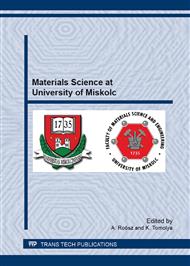[1]
Gezentsvey, L. B.: Road asphalt concrete; Moskva, Stroynadat, (1960).
Google Scholar
[2]
W. Grabowski, J. Wilanowicz: The structure of mineral fillers and their stiffening properties in filler-bitumen mastics; Materials and Structures, 41 (2008) 793–804.
DOI: 10.1617/s11527-007-9283-4
Google Scholar
[3]
J. Chen: Rheological properties of asphalt-mineral filler mastics; Journal of Materials, Concrete Structures and Pavements, 36: 571. (1997) 269–277.
DOI: 10.2208/jscej.1997.571_269
Google Scholar
[4]
D. A. Anderson: Influence of fines on performance on asphalt concrete mixtures; International Center for Aggregates Research (ICAR), 4th Annual Symposium, (1996).
Google Scholar
[5]
J. Chen, P. Kuo, P. Lin, C. Huang, K. Lin: Experimental and theorethical characterization of the engineering behavior of bitumen mixed with mineral töltőanyag; Materials and Structures, 41 (2008) 1015–1024.
DOI: 10.1617/s11527-007-9302-5
Google Scholar
[6]
Y. R. Kim, D. N. Little: Linear viscoelastic analysis of asphalt mastics; Journal of Materials in Civil Engineering, 16: 2 (2004) 122–132.
DOI: 10.1061/(asce)0899-1561(2004)16:2(122)
Google Scholar
[7]
P. S. Kandhal, C. Y. Lynn, F. Parker: Characterization tests for mineral fillers related to performance of asphalt paving mixtures; NCAT Report No. 98–2, (1998).
DOI: 10.3141/1638-12
Google Scholar
[8]
Sakharov, P. V.: Methods for designing asphalt mixtures; Transport and Roads of the city, No. 12, (1935).
Google Scholar
[9]
P. B. Sheperd: Mineral fillers in:. Bituminous materials: Asphalts, tars and pitches, Vol. 1. A. J. Hoiberg (ed. ) New York: Interscience Publishers, 1964, p.347–373.
Google Scholar
[10]
J. G. Mitchell, A. R. Lee: The evaluation of fillers for tar and other bituminous surfaces; Journal of The Society of Chemical Industry; 58 (1939) 299–306.
Google Scholar
[11]
D. J. Rigden: Mineral fillers in bituminous road surfacings: a study of filler/binder systems in relation to töltőanyag characteristics; Journal of The Society of Chemical Industry, 66 (1947) 299–309.
DOI: 10.1002/jctb.5000660902
Google Scholar
[12]
R. Lackner, M. Spiegl, R. Blab, J. Eberhardsteiner: Is low-temperature creep of asphalt mastic independent of filler shape and mineralogy? – Arguments from multiscale analysis; Journal of Materials in Civil Engineering, 17: 5 (2005) 485–491.
DOI: 10.1061/(asce)0899-1561(2005)17:5(485)
Google Scholar
[13]
G. Schramm: A practical approach to rheology and rheometry; Gebrueder HAAKE GmbH, Karlsruhe, 2nd edition, (2000).
Google Scholar
[14]
G. D. Airey, M. H. Mohammed, C. Fichter: Rheological characteristics of synthetic road binders; Fuel, 87 (2008) 1763–1775.
DOI: 10.1016/j.fuel.2008.01.012
Google Scholar
[15]
G. D. Airey, B. Rahimzadeh, A. C. Collop: Viscoelastic linearity limits for bituminous materials; Materials and Structures; 36 (2003) 643-647.
DOI: 10.1007/bf02479495
Google Scholar


